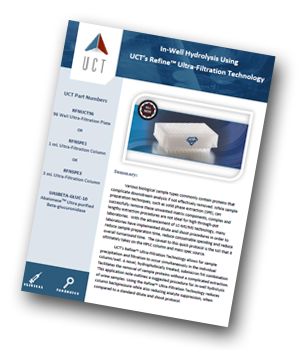UCT has produced an application note outlining a suggested procedure for in-well hydrolysis of urine samples using the company's Refine™ Ultra-Filtration Technology. Using this technology reduces column backpressure while also reducing analyte suppression, when compared to a standard dilute and shoot protocol.
 Summary
Summary
Various biological sample types commonly contain proteins that complicate downstream analysis if not effectively removed. While sample preparation techniques, such as solid-phase extraction (SPE), can successfully remove these unwanted matrix components, complex and lengthy extraction procedures are not ideal for high throughput laboratories. With the advancement of LC-MS/MS technology, many laboratories have implemented dilute and shoot procedures in order to reduce sample preparation time, reduce consumable spending and reduce overall turnaround time. The caveat to this quick protocol is the toll that it ultimately takes on the HPLC column and mass spec source.
UCT’s Refine™ Ultra-Filtration Technology allows for sample precipitation and filtration to occur simultaneously in the individual column/well. A novel, hydrophobically treated, submicron frit combination facilitates the removal of sample proteins without a complicated extraction.
Results – Analyte Suppression
Upon passing urine samples containing hydrolysis enzyme through the Refine™ Ultra-Filtration plate, analyte suppression was significantly reduced across the board for the monitored benzodiazepine and opiate panels ranging from 7-71% improvement.
Results – Backpressure Stabilization
Backpressure per sample injection was also assessed when comparing the utilization of Refine™ Ultra-Filtration clean-up technology versus a Dilute & Shoot (D&S) preparation for hydrolyzed urine samples. After 50+ injections, the backpressure remained stable when utilizing the Refine™ plate as opposed to D&S, where a drastic increase was seen after as little as 10 injections.
Conclusion
Using the above procedure, the RefineTM Ultra-Filtration technology allowed for a reduction
in instrumental backpressure and removal of unwanted matrix components in urine samples.
Overall, this allows for an end user to have enhanced analyte selectivity and an increase in HPLC/UHPLC column life. The extraction procedure can be completed in approximately 20 minutes and can easily replace a dilute and shoot protocol with minimal additional investment in laboratory resources. The hydrophobically treated submicron frit combination allows for efficient in-well hydrolysis and is amenable to both forensic and clinical laboratory settings.




